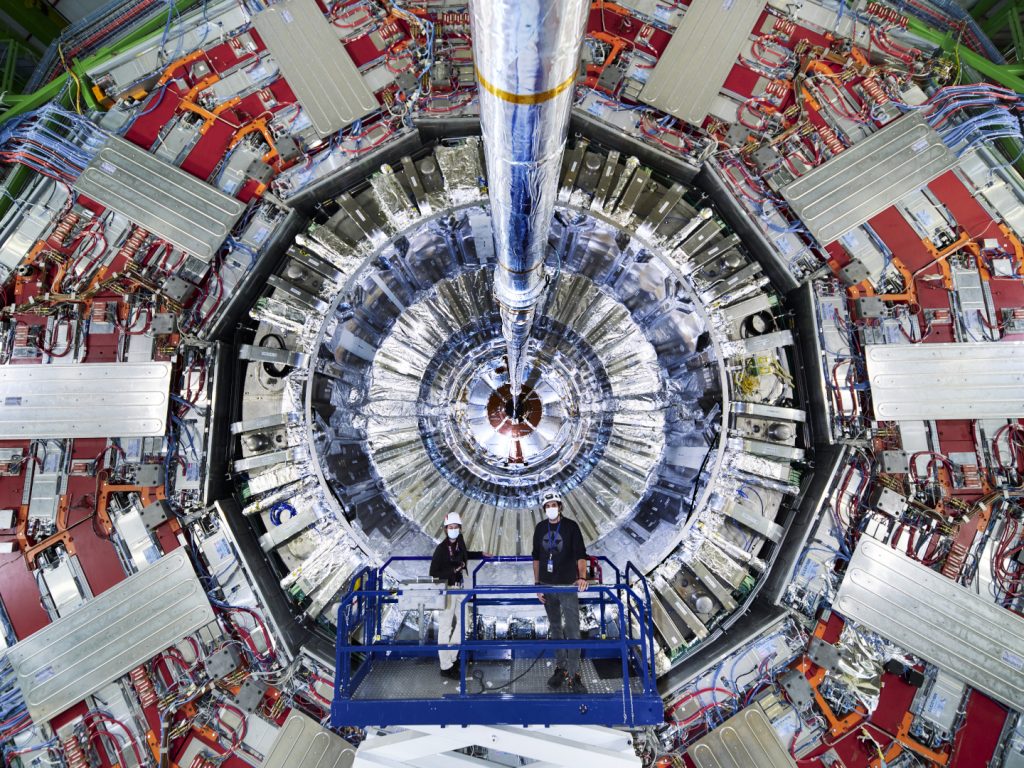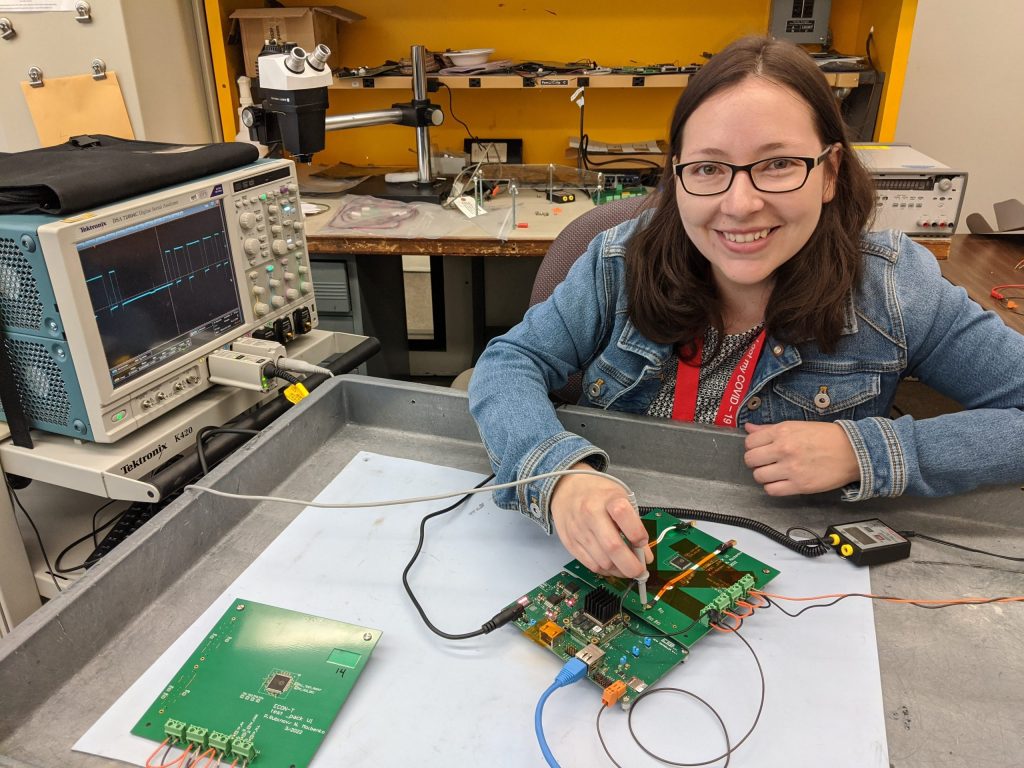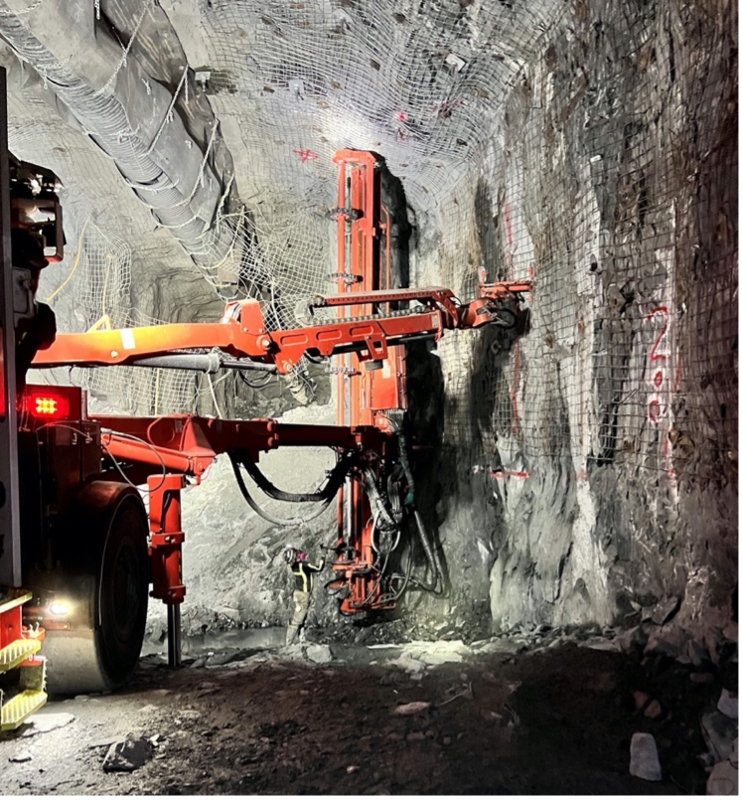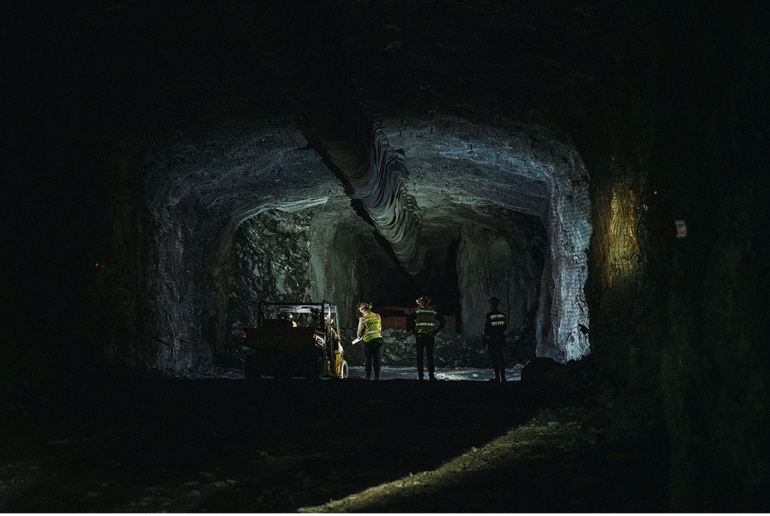The Large Hadron Collider at CERN is back in action after a three-year scheduled technical shutdown period. Experts circulated beam in the powerful particle accelerator at the end of April, and Run 3 physics started in early July at the highest collision energy ever achieved.
The LHC experiments expect to collect petabytes of data to better understand nature at the smallest scale. Thousands of collaborators are testing the Standard Model of particle physics and hunting for new physics—things like supersymmetry, dark matter or undiscovered particles.
At the same time, researchers continue to prepare for the next iteration of the LHC.
Later this decade, scientists will begin operating with an upgraded accelerator for the High-Luminosity LHC, which will collide more protons with more luminosity than ever before. With it, scientists expect to see at least five to seven times as many collisions as they do now. Researchers are building technology to improve their detectors so that they can handle the increased luminosity. The detectors are running until the end of the 2030 and will cumulate a factor of 20 more data.

The CMS detector completed several upgrades during a three-year-long shutdown to prepare for the current physics run at the LHC. Additional upgrades planned for installation during the next long shutdown will prepare the experiment for the High-Luminosity LHC. Photo: Samuel Joseph Hertzog, CERN
The CMS experiment, which co-discovered the Higgs boson in 2012, along with the ATLAS experiment, is upgrading several systems. Hundreds of people from universities and labs around the world, including U.S. institutions funded by the U.S. Department of Energy and the National Science Foundation, are designing, building and installing the new detector components. These technologies aim to improve the existing experiment, which as of today has been in operation for more than a decade.
Experts are making upgrades in six key areas: the tracker system, timing detector, trigger and data acquisition system, endcap calorimeter, barrel calorimeter and muon system. These upgrades mean CMS scientists can precisely measure and better reconstruct how particles interact in the detector. Studying their behavior may lead to new insights and potential discoveries about how our universe works.
The tracker
The CMS tracker charts a particle’s path through a magnetic field. It has two components: an inner pixel detector and an outer strip detector, both of which will be completely replaced. The tracker is the innermost area to be upgraded, closest to where the LHC’s protons collide. Because the HL-LHC will collide protons more quickly, particle paths will rapidly begin piling up.
Bjorn Burkle of Brown University works on a sensor for the CMS upgrade to the outer tracker. Photo: Nicholas Hinton, Brown University
“The new pixel detector has a finer granularity,” said Anders Ryd, the principal investigator for the National Science Foundation-funded upgrades and a professor at Cornell University. “We need higher rates and higher granularity so that they can actually detect each particle. Otherwise, you have so many particles going through that you just see a smear.”
Collaborators will add eight discs in the forward region of the inner tracker, extending the pixel detector’s coverage. To handle the rapid-fire data, the team will assemble and add thousands of small modules to the outer tracker. They’ll be equipped with sensors and application-specific integrated circuit chips that can start filtering and reducing the data immediately, enabling the outer tracker to process information at a staggering rate of 40 million times per second.
Timing detector
CMS researchers are building a brand-new layer outside of the tracker called the Minimum Ionizing Particles, or MIP, timing detector. The timing detector mitigates pile-up, or a tangled mess of particle paths, by giving researchers information on when a particle entered the detector. Using unprecedented precision in measuring the time of arrival of particles will allow researchers to distinguish individual paths and reconstruct them in 4D.
“We are adding a detector layer that will give us a precision timing measurement of individual charged particles from LHC collisions along their path,” said Patricia McBride, a scientist at the DOE’s Fermi National Accelerator Laboratory who, elected by 3,000 physicists in the international CMS Collaboration to the role, will become head of the collaboration early this autumn. “This will give us information about the type of particle it is and which primary collision it came from. We will be able to use space and time information to identify the interesting tracks in the event.”

Fermilab Lederman Fellow Cristina Mantilla Suarez tests the ECON-T integrated circuit designed for the HGCAL detector upgrade. Using artificial intelligence to compress HGCAL data, it selects and compresses 15 billion bits of data per second for transmission off the detector. Photo: James Hirschauer, Fermilab
The timing detector is shaped like a barrel with two endcaps, and its airtight seal will prevent energy loss and keep out dust. The upgrade team is now designing and building modules, electronics and software for this timing detector.
Trigger and data acquisition
The CMS trigger selects potentially interesting collision events and captures relevant data, discarding more scientifically benign events to keep the amount of data manageable. When operational, one of the new triggers will take in information from the upgraded outer tracker. Importantly, the new trigger will employ artificial intelligence and machine learning in its data acquisition of the large volume of data expected from LHC collisions.
The CMS experiment, which co-discovered the Higgs boson with the ATLAS experiment in 2012, is upgrading several systems. [Researchers] are designing and building the new detector components, and once installed, these technologies will improve the existing experiment, which has been in operation for more than a decade.
“We need to introduce some smartness into the event selection early on,” said Vaia Papadimitriou, who is the deputy manager of the upgrade project and a scientist at Fermilab, the host laboratory for the US-CMS collaboration. “This lets us reduce the amount of data we need to process and helps us eliminate background signals that would get in the way of what we’re actually trying to study.”
Upgrades to the data acquisition system will allow the team to collect data more quickly to keep up with the increased LHC collision rates.
Calorimeters
CMS is equipped with barrel and endcap calorimeters, detectors that measure particles’ energies.
The endcap calorimeter flanks the inner detectors and analyzes the particle showers from collisions. The current endcap calorimeter will be completely replaced by a new, high-granularity calorimeter, or HGCal, the first of its kind to be used at a collider experiment.

CMS collaborators calibrate a prototype module for the HL-LHC TFPX detector at the University of Illinois Chicago HEP silicon lab. Photo: Cecilia Gerber, professor at the University of Illinois Chicago
The detector will have excellent time resolution and incredibly fine spatial resolution, which allow precise reconstruction of the many particles produced. To build it, collaborators will assemble tens of thousands of modules with small silicon or scintillator sensors. The modules will form hundreds of cassettes, which incorporate the integrated circuits and electronics that can handle data directly on the detector and transmit it to the data acquisition system.
The team is also upgrading part of the barrel electromagnetic calorimeter. “We’ll replace what we call the ‘front-end electronics,’ the electronic system installed right there on the detector,” said Paolo Rumerio, the deputy upgrade coordinator and a physicist at the University of Alabama. The new system will be able to handle the increased flow of data.
“These calorimeters will provide a wealth of information that will enable CMS to reconstruct energy deposits, or showers, that come from different particles,” Rumerio said. “The energy and precise timing of each particle can be measured and used in the data analysis.”
Muons
Collecting information on muons is essential for CMS, as one would expect from its name: the Compact Muon Solenoid. The muons from particle collisions can travel fairly far without interacting, so this layer of the detector sits outside the calorimeters.
The new muon system will have upgraded electronics, better time resolution and an increased ability to detect muons coming off the beam at a wider range of angles. Several new electronic boards will handle data processing and readout. Collaborators are also improving the firmware and software used to control the electronics on these boards.
“The MREFC [Major Research Equipment and Facility Construction project] supported upgrades to the forward muon detectors include new electronics to support the higher data rates at the HL-LHC, as well as readout of new Gas Electron Multiplier detectors that will extend the muon detector coverage closer to the beam line,” Ryd said. “These upgrades will provide a significant enhancement of the CMS muon detection capabilities.”
Moving forward
Today, upgrades for the CMS detector are at different stages, but all will follow a similar path. After years of development and prototyping, the collaboration now moves to build or acquire the parts, begin fabricating system components at different U.S. laboratories, vet them with rigorous testing, and then deliver them to the experiments at CERN. Scientists will install the upgrade components during the LHC’s third long shutdown, currently scheduled to take place from 2026 to 2028.
Once the HL-LHC starts up, the increased data volume will help researchers search for rare physics processes and further investigate the Higgs boson. Researchers believe the Higgs provides the mechanism by which all other particles get their mass, but scientists still have a lot to learn about the universe by studying the particle to greater precision.
“The Higgs boson is such a fundamental particle that discovering it is not good enough,” Papadimitriou said. “We need to have a lot of complementary information in order to study all the properties of the Higgs boson. And because the Higgs boson is predicted by the Standard Model, if we find any properties to be different from what the Standard Model predicts, it’s a major breakthrough.”
Fermi National Accelerator Laboratory is supported by the Office of Science of the U.S. Department of Energy. The Office of Science is the single largest supporter of basic research in the physical sciences in the United States and is working to address some of the most pressing challenges of our time. For more information, please visit science.energy.gov.
Around a mile below the surface in South Dakota, construction crews are hard at work excavating around 1,000 tons of rock per day. Their goal is to make room for a large underground facility that will house an international effort aimed at studying neutrinos—highly elusive subatomic particles that may hold the key to many of the universe’s secrets.
The Long-Baseline Neutrino Facility will one day be home to the international Deep Underground Neutrino Experiment, hosted by the U.S. Department of Energy’s Fermi National Accelerator Laboratory. LBNF/DUNE involves more than 1,000 scientists and engineers from over 30 countries.

A construction miner stands near a bolter, a huge machine that installs 20-foot-long rock bolts in the caverns that will house the Deep Underground Neutrino Experiment. About 16,000 bolts will need to be installed to provide ground support in the gigantic, seven-story-tall caverns a mile underground. Photo: Jason Hogan, Thyssen Mining Inc.
DUNE has three main scientific aims: determine whether neutrinos might hold the key to the matter-antimatter asymmetry that gave rise to our matter-filled universe; look for neutrinos that indicate the birth of a neutron star or black hole, two of the most mysterious objects in space; and search for subatomic signals that could help scientists develop a theory that unifies the four forces of nature.
“DUNE is a unique experiment,” said DUNE co-spokesperson Sergio Bertolucci. “It is the only experiment where you can measure all the parameters of neutrino oscillations in the same place. This will enable us to perform precision measurements of the mass ordering, of the matter-antimatter symmetry violation and of the mixing angles.”
LBNF provides the space, infrastructure and particle beam for the experiment: the caverns that will house DUNE’s detectors—a near detector at the Fermilab site, and a far detector 800 miles away at the Sanford Underground Research Facility in South Dakota; the space for cryogenic equipment to keep these instruments cold; the hall where neutrinos are produced; and the beamline that will deliver the protons that make the neutrinos.
PIP-II, the Proton Improvement Plan II at Fermilab, will power the particle beam for the experiment. At the heart of PIP-II is the construction of a 700-foot-long particle accelerator that will boost a stream of protons to 84% of the speed of light. The construction of the first of two large buildings for PIP-II is almost complete. When operational, PIP-II will feed its protons into a chain of accelerators to create the world’s most intense neutrino beam.
Excavation is in full swing
On-site prep work for the excavation of the LBNF far site facility in South Dakota began in 2019. In 2021, construction crews started the excavation of the large caverns for DUNE. The three LBNF caverns will house the far detector modules and the infrastructure needed to operate the detectors. Project managers expect the construction of the caverns to be complete in 2024.
“It doesn’t matter how many times you see it—these caverns are gigantic. It’s very impressive to see.” – Josh Willhite
To date, approximately 274,000 tons of rock have been removed—more than a third of the whopping 800,000 tons that needs to be extracted from a mile underground. About 200 people in South Dakota directly work on LBNF during this phase of the project.
Once complete, the underground facility with its three caverns will cover the area of about the size of eight soccer fields. Two of the caverns are about 500 feet long, 65 feet wide and 90 feet high—about the height of a seven-story building. These caverns will house the far detector modules, each of which will be more than 200 feet in length and contain 17,000 tons of ultrapure argon cooled to minus 184 degrees Celsius. The third cavern, which is about 625 feet long and 65 feet wide but is only 36 feet tall, will contain the cryogenic support systems, detector electronics and data acquisition equipment.
Drill and blast
The excavation of each cavern proceeds from the top to the bottom. The process is carried out by contractor Thyssen Mining Inc. and uses the so-called drill-and-blast technique. First, construction workers drill a series of holes, then load those holes with explosives that will blast away the rock. The workers then remove the blasted rock and transport it to large buckets called skips, which travel up a mile-long shaft to bring the rock to the surface. Once the rock is above ground, it is crushed, put on a conveyor, and then deposited into a former open mining pit called the Open Cut.
Next, workers move into the excavated space to conduct ground support, which involves operating gigantic drills that insert 20-foot-long bolts into rock walls as anchors. Miners will install a total of about 16,000 rock bolts to secure all walls and ceilings of the excavated space.
“These secure the rock because sometimes, in the process of blasting, you create fractures in the surrounding rock, or there’s existing fractures,” said Syd De Vries, a mining engineer at Fermilab. “That creates zones of weakness, so you install these rock bolts, along with a wire mesh that secures the rock so that it’s safe to go in and repeat that cycle.”
Once the ground support is complete, the drill-and-blast cycle begins anew. Some of the underground work can be carried out in parallel, with approximately 30 miners per shift working at different locations.
The drill-and-blast phase will be complete in the fall of 2023. “That’s the last time we’ll use explosives,” said Josh Willhite, a mechanical engineer who grew up in South Dakota and started working on the early plans for this project in 2010.
To complete the construction of the caverns, the floors and walls will be covered with concrete—and that work is expected to continue until May 2024.
Advances at all levels
While the excavation work proceeds, another set of contractors is preparing for the building and site infrastructure phase. During this phase, the LBNF space will be outfitted with the infrastructure needed to run the DUNE detectors. This includes setting up the lighting, electrical equipment, ventilation and piping that will direct argon delivered at the surface to the detectors deep underground.
Work on the DUNE particle detectors is advancing as well. For example, scientists in the UK have begun the mass production of large detector components for the first detector module in South Dakota. At the European laboratory CERN, the DUNE collaboration is about to start tests for vertical-drift detector components, which will be used in the second detector module to be built in South Dakota. At Fermilab, scientists are getting ready to test near-detector components built in Switzerland.
Prep work is paying off
Before the drill-and-blast process could begin in South Dakota, the project team completed the pre-excavation phase, during which the LBNF far site was prepared for the excavation. It involved, among other things, renovating the Ross Shaft, updating the rock crushing system and building the 3/4-mile-long conveyor system that moves the rock from the shaft to the Open Cut. “That was a pretty major scope of work,” Willhite said. “Seeing all that functioning and working properly once we got into excavation was pretty exciting.”

Work in progress: About 800,000 tons of rock need to be removed to create the seven-story-tall caverns and the connecting drifts for the LBNF far site location in South Dakota. Photo: Adam Gomez, SURF
During that phase, engineers also drilled a series of core samples to determine the geological characteristics of the rock, such as its strength and the presence of fractures, as well as the stresses that were present. Stresses on the rock exist both in the vertical and horizontal planes. The deeper you go, the greater the weight of the rock becomes, creating stress in the vertical plane. Horizonal stresses are caused by things like the tectonic activity of the Earth.
This diligent pre-excavation work has paid off. Project managers think that any big issues would have come up during the first year of excavation, but so far, the miners have successfully excavated the tops of all three caverns and have opened one of the caverns to its full width without any major setbacks. “The sensors that have been installed and are monitoring the rock movement are all following the predicted paths,” said De Vries. “That gives everybody a higher sense of security.” The monitoring, of course, continues, and the safety of all workers remains the project’s top priority.
Breaking the 625-foot-long utility cavern to its full length, then being able to walk along it, was an amazing feat, Willhite said: “It doesn’t matter how many times you see it—these caverns are gigantic. It’s very impressive to see.”
Fermi National Accelerator Laboratory is supported by the Office of Science of the U.S. Department of Energy. The Office of Science is the single largest supporter of basic research in the physical sciences in the United States and is working to address some of the most pressing challenges of our time. For more information, please visit science.energy.gov.
